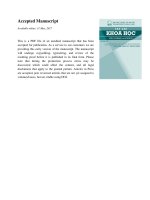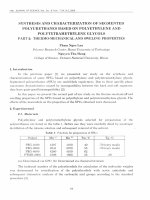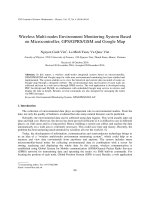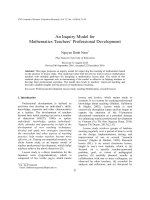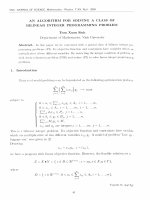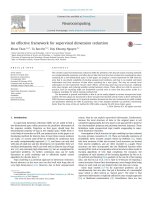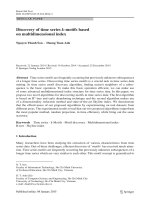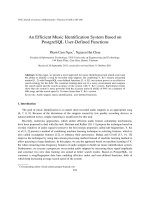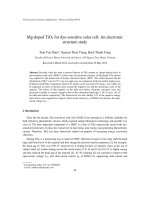DSpace at VNU: An efficient method for fingerprint matching based on local point model
Bạn đang xem bản rút gọn của tài liệu. Xem và tải ngay bản đầy đủ của tài liệu tại đây (189.44 KB, 6 trang )
An Efficient Method for Fingerprint Matching
Based on Local Point Model
Nguyen Thi Huong Thuy1, Hoang Xuan Huan2, and Nguyen Ngoc Ky1
1
2
Information Technology Faculty, Vietnam National
University - Hanoi College of Technology,
General Department of Technique - Logistic,
Vietnam Ministry of Public Security
,
Abstract - This paper proposes a fingerprint matching method
based on local Thin-Plate-Spline (TPS) deformation model, a
warping technique, to deal with non-linear distorted fingerprints.
After determining the set of corresponding minutiae pairs
between two fingerprints by using an affine transformation, a set
of corresponding pseudo-minutiae pairs are created based on
their local ridge-valley structure comparison. These points are
associated with the known corresponding point pairs to select a
suitable landmark point set for using Local Thin Plate Spline
deformation model over 9 partial areas of fingerprint images in
order to find new corresponding minutiae pairs. This procedure
is repeated until no more new corresponding minutiae pairs are
distinguished or the number of corresponding point pairs is large
enough. The experimental results on the database FVC2004 show
that the proposed method significantly improves matching
performance compared to the global TPS warping method.
Keywords: Fingerprint verification; Minutiae matching; Elastic
deformations; Thin-Plate-Spline models; Local deformation
models.
I. INTRODUCTION
Automatic Fingerprint Identification and Authentication
(AFIA) is a biometric technology which had been considered
for a long time [13] but it is still an active research area [4, 7,
8, 13, 15]. In the fingerprint identification system, the
matching algorithm is the most important stage. Many
fingerprint matching algorithms have been published [4, 7, 8,
13, 14, 15], and can be classified into three main categories
[12] based on: minutiae sets, texture and greyscale correlation.
The minutiae based [5, 7-11, 15, 19], the most widely used
algorithm, is of concern in this paper.
In a fingerprint image, minutiae such as end points or
bifurcation points are called the minutiae. In order to match
the query fingerprint image Iq with the template fingerprint
image It in a database, a general approach of the fingerprint
matching algorithm based on minutiae attempts to estimate the
affine transformation to align two minutiae sets of two
fingerprint images originated from the same finger so that the
respective minutiae pairs “match fit” together in pairs. The
most popular but simple deformation is affine deformation
(combining translation, rotation and scale). However, in
general, distorted fingerprint is non-linear therefore the
mathematical efficiency using affine transformation is limited.
Nowadays, it usually used for simple matching as an initial
stage and then warping methods are applied [10, 12] to
determine the similarity scores of two fingerprints. Amanssa
et al. [1] and other authors [2, 5, 11, 12, 17] used additional
sheets tuning adapter model (thin-plate spline: TPS) in this
procedure. Particularly, after using affine transformation to
calculate the number of corresponding minutiae pairs, Li et al.
[12] used these corresponding minutiae pairs for landmark
points which help warping TPS and combined with greyscale
978-1-4673-2088-7/13/$31.00 ©2013 IEEE
correlation to decide the similarity. This method is called
global TPS.
In global TPS, we have to calculate local correlation and
solve simultaneous linear equations. The size of these linear
equations directly proportionates to the number of landmark
points. It normally takes a considerable amount of calculation
time when landmark points are large. Moreover, this method
cannot process distorted fingerprints in image’s area which is
far from landmark point pairs.
In facts, the efficiency of warping TPS depends on the
distribution of landmark points on fingerprint images. Points,
which are far from landmark points, will be variously affected
by non-linear distortion and give different matching results.
Furthermore, by using affine transformations, the originally
detected landmark points are normally focused on the little
nonlinear deformed area. It makes a paradox: the no need
warping and less distorted areas contain too much landmark
points whereas the far and more deformed areas have no
landmark point for warping.
In order to improve this approach, we propose a warping
method P-TPS with two steps. The first step is to determine
the set of initial corresponding minutiae pairs by applying an
affine transformation then using the sequence of quantized
points of their ridge-valley pair associated to choose the set of
landmark points with higher reliability. The second step is
based on convex hull of all known corresponding pairs,
fingerprint images are divided into 9 areas. New created
corresponding points are combined with available
corresponding minutiae pairs to choose suitable landmark
points on each area for warping in order to calculate new set
of corresponding minutiae pairs. The new set of
corresponding minutiae pairs is able to reuse iteratively until
there are no more corresponding point pairs or the number of
corresponding pairs is large enough to distinguish.
Our new method is suitable for both roll/full and plain/flat
fingerprint images. Experimental results on the database of the
fingerprint FVC2004 (DB1 and DB3) [20] show that our
proposed method provides better results than global TPS
method. Calculation time and memory usage also has been
significantly reduced.
The rest of the paper is presented as following: Section 2
introduces the method of fingerprint matching based on
minutiae and some methodologies which will be used. New
proposed algorithm is described in Section 3. Section 4
presents experimental results and the final section is reserved
for evaluation and conclusion.
II. MINUTIAE BASED FINGERPRINT MATCHING AND RELATED
WORKS
This section briefly introduces minutiae based matching
method, distorted TPS model and global TPS method.
334
A. Fingerprint matching problem and matching scheme
based on minutiae
Fingerprint matching problems can be described as
following: Give a query fingerprint Iq and a template
fingerprint It, it is to determine whether the two images are
originated from the same finger or not. The answer is firstly
determined by calculating the similarity scores and then by
decision yes or no base on the similarity threshold.
Fingerprint matching algorithms can be classified into three
main categories [12] based on: minutiae, texture and greyscale
correlation. Within these categories, the method based on
minutiae is simple but yet efficient therefore it is the most
widely used in [5, 8-10, 15, 19]. A short scheme of this
method is outlined below and the detail is in [10, 14].
(combined with linear transformations: translation, rotation
and scale). However, due to the nonlinear distorted
fingerprints when capturing fingerprint images, the efficiency
of this method is not enough and is usually employed to
determine initial corresponding minutiae pairs for advanced
warping methods. One of widely used warping
transformations is TPS deformation model in [1, 2, 8 -10, 15,
19].
The thresholds Stmax and Stmin together with the false
rejected rate FRR(St) and the false accepted rate FAR(St) as
function of St are commonly determined by learning on the
two sets of genuine and impostor fingerprint images. In this
case, Stmax is the largest value for FAR = 0 and Stmin is the
smallest value for FRR=0.
1) Minutiae based method
In a fingerprint image, points, which represent
discontinuities of fingerprint local structure such as end
points, bifurcation points, are called minutiae.
From two fingerprint images Iq, It, we define two sets of
minutiae Mq and Mt as follows:
Mq = {m1, m2, …, mM}; with mi= (xi,yi,θi), i = 1,...,M
(1)
where (xi, yi) are coordinates of mi on the image plane R2 of Iq,
and θi is the fingerprint direction at mi.
Mt = {m1’, m2’, …, mN'}; with mi'= (xi’,yi’,θi’), i = 1,..,N (2)
where (xi’,yi’) are coordinates of mi' on the image plane R2 of
It, and θi’ is the fingerprint direction at mi'.
B. Thin-Plate Spline deformation model and global TPS
matching
2) Matching scheme based on minutiae
A suitable aligned transformation from image plane of Iq to
image plane of It is required to determine corresponding point
pairs of Mq and Mt. Point pair mi (Mq) and mj'(Mt) are called
correspondent if image mi” of mi via this transformation
belongs to the neighbourhood (with a small values of r and θ)
of mj'. In this case, it is said that mi matched with mj'. When
two images Iq and It are genuine (from the same finger), the
number of corresponding minutiae pairs is much more than in
the case they are impostor (not from the same finger). In fact,
due to non-linear distorted fingerprints and noise, even two
images are genuine, it is not simple to find corresponding
minutiae pairs.
Suppose that there are n corresponding minutiae pairs
found from two images, M is the number of minutiae on the
query fingerprint and N is the number of minutiae on the
sample fingerprint, the similarity of two fingerprint images is
characterized by the measurement S(It,Iq) given by the
following formula:
S(It,Iq) = n2/M× N.
(3)
In the general algorithm, one is interested only in the
similarity S(It,Iq), which is also the output.
Based on predefined thresholds of scores Stmax and Stmin, we
conclude that two fingerprints are matched if S(It,Iq) > Stmax,
otherwise they are mismatched (S(It,Iq) < Stmin). For the pairs
of fingerprints having the similarity scores in interval [Stmin,
Stmax] the warping stage is needed.
The simplest and most general transformation used in
matching methods to align two images is affine transformation
1) Thin-Plate-Spline deformation model
After determining the n pairs of corresponding minutiae by
using affine transformations for creating an initial set of
landmark points, the image is warped by TPS model [1], [11].
This method uses affine transformations and radial
interpolation functions of two-dimensional as follows:
n
f(x,y) = a1 + axx + ayy +
∑ w U ( P − ( x, y ) )
i
i
(4)
i =1
Where,
U ( r ) = r 2 log r ,
(u, v) = u 2 + v 2 and
by convention U(0)=0; Pi are landmark points, the first three
terms describes full affine transformations with affine
parameters a1, ax, ay and the rest term describes the non linear
deformation with weight values wi which need to find so that
the landmark points matched.
The coefficients of f(x,y) transformation are determined by
solving linear equations (4). Based on this warping method, if
two fingerprints are genuine, it is expected to detect more new
corresponding point pairs for calculating similarity. Actually,
while determining corresponding minutiae pairs based on
tolerance, there are some ambiguity correspondence cases. In
order to overcome this issue, the two-way graph and FordFulkerson algorithm are applied to determine this
correspondence [16, 19]. Occasionally, additional local
information of minutiae pairs is used as secondary feature [9],
[10]. Based on this technique, the similarity between
corresponding pairs could be calculated by using local
greyscale correlation [12].
2) Global TPS matching
Li et al. [12] proposed fingerprint matching method known
as global TPS. In this method, after determining TPS
transformation, they calculate local greyscale correlation in
corresponding pairs. Based on the similarity of corresponding
pairs via this greyscale correlation, the decision for
identification is then determined. The detail of this method is
given in [12].
335
III. NEW METHOD: PARTIAL TPS FINGERPRINT MATCHING
The TPS method is a good solution to overcome non-linear
non
distorted fingerprints but it still has some following
disadvantages:
i) By considering all sets of initial corresponding minutiae
pairs as landmark points without using local information
info
for
verification, it is easily to introduce some false landmark
points. However, using local greyscale correlation before
warping is not reliable because it is highly sensitive with
distortion, noise, and incomplete information.
ii) Because landmark
k points are determined by global affine
transformation, therefore they generally focus on areas with
only few non-linear
linear distortions and not distributed equally
over the entire overlapping area of two fingerprints It and Iq.
Therefore, minutiae which are far away from non
non-linear
distorted landmark points, are often disregarded.
iii) Warping global fingerprint one requires solving large
linear equations that takes a lot of calculation time but the
result normally has high variation. In reality, fingerprint
distortion is local natured and closer points have fewer
distortions.
In order to overcome the first disadvantage, we propose
using local structure known as ridge-valley
valley pair associated
with each minutia to verifying and select a set of
corresponding minutiae
iae pairs with higher reliability. In order
to deal with the second disadvantage, our method proposes an
additional technique to strengthen the set of landmark points
by utilizing more pseudo-minutiae
minutiae belonged to this ridgeridge
valley pair associated. Based on the distribution of pseudopseudo
minutiae on fingerprint image, a subset with more equal
distribution on the overlapping area of two fingerprints is
chosen as additional landmark points for warping. Finally, our
method uses partial TPS warping method instead of global
TPS method to overcome the third disadvantage.
A. Associated ridge-valley
valley structure and pseudo-minutiae
pseudo
1) Associated ridge-valley structure
As aforementioned, components of the minutiae including
only positions and orientations do not have enough
information
rmation to present the local structure, therefore Ross et al.
[18] proposed to use associated ridge information to match
corresponding minutiae pairs. In order to get more local
information at these points, we also considered the valley
which associated with
th dual minutiae on the valley image. Our
consideration is based on the duality that can be formulated as
follows: Opposing with a minutiae "bifurcation/end" point on
the ridge image, there always exist a dual minutiae
"end/bifurcation" point on valley image.
ge. It is also true for
valley images (negative image). Thus ridge-valley
ridge
pair
associated with one minutiae composed from associated ridge
with this minutiae and associated valley associated with its
dual one on the valley image. Fig. 1 describes some minu
minutiae
on the ridge image and its dual minutiae on the valley image.
(a)
(b)
Fig. 1: The minutiae on the ridge (thick line) have it's dual minutiae on the
valleys (thin line).
Some configurations of figured minutiae with their ridge
ridgevalley pair associated are described in Fig. 2.
(a)
(b)
(c)
(d)
Fig. 2 (a) A "short ridge or island" and its dual valley form "lake"; (b) A
"spur form" ridge and its dual spur form valley reverted; (c) A "Crossover"
and its dual "two meeting ridges"; (d) Not exist the dual for line break, the
extracted minutiae is rejected.
2) Sampling ridge-valley
valley pair associated and appending
corresponding point pairs
Note that l0 is the length (usually chosen as the double
distance of ridges space) and lmax =4l0. The set of pseudo
minutiae is generated on associated ridge
ridge-valley structure of
corresponding minutiae pairs as follows: From each minutiae,
on ridge image and from dual minutiae on valley image we
used the contour tracing algorithm proposed in [10] to
following along ridge and valley to sampling quantized points
with equidistant step l0 until meeting the border or the length
overcome the threshold lmax. These quantized po
points of two
corresponding minutiae are characterized by positions and
directions hence called pseudo-minutiae.
minutiae. For each genuine
corresponding minutiae pairs, ridge-valley
valley pair associated is
also corresponding, but it is not true for impostor case.
Therefore,
e, after checking the coordination and the orientation
of these pseudo-minutiae,
minutiae, we select only corresponding
pseudo-minutiae
minutiae to append into set of landmark points. Fig. 3
described pseudo-minutiae
minutiae sampled with equidistance of l0.
Pseudo point
mj
Fig. 3 The minutiae mj and its sampled points with equidistance l0
B. Area Division and choice the landmark points set for local
deformation model.
In order to warp the image using partial TPS, it is required
to divide an image into 9 areas and choose landmark points
for TPS transformation of each area.
1) Area Division for TPS warping
336
For each known corresponding minutiae pairs set, it is
possible to estimate the aligned region by determination their
convex hull on the image plane based on the proposed
technique in [6]. The largest diameter of convex hull is chosen
as the horizontal axis of corresponding image plane and the
center is its midpoint. We divided the plane into 8 areas by 8
rays from center with an angles separated regularly of 450.
Taking central area with radius R0 (predefined as 4mm), the
outside is 8 areas separated by rays. So fingerprint image is
divided into 9 areas to compare minutiae.
Procedure P-TPS Fingerprint Matching
Input: Two sets of minutiae Mt, Mq with M, N; The initial
corresponding minutiae pairs set M1 with n pairs [21], Set M1 *
with n* of quantized points (pseudo minutiae). Warping threshold
Stmin , Stmax ; ridge step: step;
Output: The corresponding minutiae pairs set with n" pairs found
after warping and overall similarity of the two fingerprints S.
1. Verification the initial set of corresponding minutiae pairs by
comparing two pairs vectors of quantized points sampled from its
the ridge-valley pairs associated (n – the original minutiae pair),
The output result of this step is the number n' (<= n) of
corresponding pairs of minutiae.
2. Similarity calculation S = n'2/(nt*nq). If If S ∉ [Stmin , Stmax],
passing to 6;
3. Increasing the number of landmark points by adding more
quantized points (pseudo minutiae).
3.1. Adding pseudo minutiae on the ridge-valley pairs
associated to the set M1 , the result: M1 + M1 *. (n*+n' is the
total number of corresponding minutiae and pseudo minutiae
pairs).
3.2. Calculating the convex hull of M1 + M1* using algorithm
[5].
4. Spatial Filtering on M1 + M1* and landmark points selection
4.1. Spatial Filtering using square grid by selecting a set of m
corresponding points on the m square grid;
4.2. Selecting the sets of landmark points for 9 divided areas;
4.3. Warping partial using TPS deformation model on each
divided area and calculating new set NewM1 of corresponding
minutiae pairs with cardinal (NewM1)= n".
5. If (n' = n") passing to 6, if not:
5.1. n'← n"; M1 ← NewM1
5.2. come back 2;
6. Return Output: M1 and S;
2) Choice the landmark points set for local TPS deformation
model
For each considered area, it is possible to determine square
grids with the size step of 4mm on a image with standard
resolution. On each grid square, we choose at most one
landmark point (if it is available) from the set of
corresponding minutiae or pseudo minutiae according to the
following priorities: The minutiae nearest grid’s central
square, left to right and top to bottom. Based on the method of
sampling in III-A, this set of landmark points is determined by
pairs. If there are only few landmark point pairs on this area, it
is possible to reuse nearest points in adjacent areas to find
TPS transformation.
Now we describe our P-TPS algorithm to match
fingerprints by using the above model.
C. P-TPS algorithm
Given two set of minutiae Mt and Mq of the sample ridge It
and the inquiry ridge Iq; applying affine transformation to
obtain corresponding minutiae pairs set M1 and all its rigevalley pairs associated, the fingerprint matching method
applying P-TPS is described in Fig. 4.
In this algorithm, based on predefined thresholds of scores
Stmax and Stmin, we conclude that two fingerprints are matched
if S(It,Iq) > Stmax, otherwise they are mismatched (S(It,Iq) <
Stmin). For the pairs of fingerprints having the similarity scores
in interval [Stmin, Stmax] the warping stage is needed.
In the warping stage of algorithm, based on the initial
corresponding minutiae pairs set and initial similarity score, a
set of corresponding pseudo minutiae pairs is generated by
their ridge-valley pairs associated to increase the selection
space to choice only the small subset of landmark points more
regularly distributed in each area for using a local warping
model. According to warped coordination results, the
algorithm detects more new genuine corresponding minutiae
pairs over each partitioned area and recalculating the global
similarity between two images.
In this algorithm we also used a newer version of the
similarity formula in 3. Replacing M and N in (3), we only
considered nq, nt, the minutiae number respectively belonged
to the aligned region of two query and template fingerprints
estimated at each step from convex hull of the set of expanded
landmark points. This procedure is repeated until the
correspondent set is large enough or new corresponding
minutiae pairs are not found.
Fig. 4 Description of P-TPS matching algorithm
IV. EXPERIMENTAL RESULTS
Although our experimental results on rolled/full fingerprint
images database show that proposed method give significantly
better results than global TPS method, for more objective
evaluation, this section presents experimental results on
FVC2004 (DB1, DB3) [20]. Each database in FVC2004 has
several significant deformation fingerprints. Each set contains
800 fingerprints images of 100 different fingers, 8 different
images for each finger. DB1 includes fingerprints collected by
the optical sensor “CrossMatch V300”, DB3 is collected by
the thermal sensor “FingerChip FCD4B14CB” of Amtel.
Performing matching on each DB, we examine 2800
iterations for matching fingerprints of same fingers and 4950
test iterations to match fingerprints of different fingers to
estimate the Genuine and Impostor distribution. Based on
estimated distributions, the errors FAR, FRR and FAR100,
FAR1000, zeroFAR, zeroFRR as requirements by protocol of
FVC2004 [20] are caculated. Threshold values Stmin, Stmax
then determined from zeroFRR and zeroFAR.
The results of two warping method are described in Table
1, the comparison of two curves ROC on DB1, DB3 databases
shown on Fig. 5.(a) and 5.(b) respectively.
The comparison of experimental results based on time and
memory usage of our proposed method P-TPS with TPS
Global method using DB1, DB3 database is shown in Table 2.
337
The results of two warping methods applied to the same
database show that P-TPS warping method achieves higher
accuracy than global warping method on all evaluated
parameters.
(b) FVC2004 DB3
(a) FVC2004 DB1
Fig. 5 Comparison the ROCs of global TPS method and P-TPS method on FVC2004 DB1, DB3.
TABLE 1: COMPARING THE PERFORMANCE OF TWO MATCHING ALGORITHM ON FVC 2004 DB1, DB3
FVC2004
DB
DB1
DB3
Average
EER
Global-TPS
P-TPS
FAR100
Global-TPS
P-TPS
4.89%
1.97%
3.43%
5.34%
1.98%
3.66%
3.38%
1.25%
2.32%
3.14%
1.27%
2.21%
FAR1000
GlobalP-TPS
TPS
5.82%
3.73%
3.83%
2.97%
4.83%
3.35%
zeroFAR
Global-TPS
P-TPS
29.60%
9.18%
19.39%
14.02%
7.19%
10.61%
TABLE 2: COMPARISON THE TIME AND MEMORY CONSUMPTION OF TWO METHODS ON FVC 2004 DB1, DB3
FVC2004
DB
DB1
DB3
Average
Genuine
Time (ms)
Memory (Kbytes)
Global-TPS
P-TPS
Global-TPS
P-TPS
83.4
78.33
307.56
1.79
60.7
46.65
144.46
2.35
72.05
62.49
226.02
2.07
In more details, the average EER of P-TPS (2.32%) is
smaller than Global TPS (3.43%). The average comparing
time of P-TPS is 62.49 ms with Genuine matching and
40.62ms with Impostor matching, smaller than Global TPS’s
average is 72.05ms with Genuine matching and 68.31ms with
Impostor matching. Regarding the memory usage, P-TPS
method uses only 2.07 Kbytes with Genuine matching and
0.95 Kbytes with Impostor matching, a lot of reduction
comparing with Global TPS’ result is 226.02 Kbytes with
Genuine matching and 224.39 with Impostor matching can be
explained by fact that the Global TPS' method requires a lot of
memory to store the original fingerprint image for calculation
of correlation while our proposed method does not require it.
All experiments are performed on the same computer with
CPU Intel Pentium 4, 2.8 GHz.
V. CONCLUSION
In this article, we have proposed a new method to match
fingerprints using local TPS deformation model. The
Impostor
Time (ms)
Memory (Kbytes)
Global-TPS
P-TPS
Global-TPS
P-TPS
83.37
47.06
306.66
0.91
53.25
34.18
142.11
1.08
68.31
40.62
224.39
0.95
advantage of our new method is the introduction to use
pseudo-minutiae extracted from ridge-valley pairs associated
as a highly reliable local information without complicated
calculations. These new aided pseudo minutiae set together
with initial set of corresponding minutiae give us more
alternatives to choose the set of landmark points which reflect
better the local distortion and distributed more regularly on he
image plane. Thus they give better warping performance when
the fingerprints are non-linear distorted. By modifying global
warping method, our proposed local warping method therefore
provide more reliable answers.
Experimental results on FVC 2004 (DB1, DB3) databases
show that comparing with the global TPS method, our new
method significantly increases matching efficiency by
improving both genuine and impostor distribution, therefore
reducing simultaneously both FAR and FRR parameters.
Furthermore, our proposed method reduces the calculation
time and memory usage.
Acknowledgement
338
This work is partially supported by Vietnams National
Foundation for Science and Technology Development
(NAFOSTED, Project:102.01-2011.21 ).
REFERENCES
[1]
[2]
[3]
[4]
[5]
[6]
[7]
[8]
[9]
A. Almansa and L. Cohen, Fingerprint image matching by
minimization of a thin-plate energy using a two-step algorithm with
auxiliary variables, in Applications of Computer Vision, 2000, Fifth
IEEE Workshop on., 2000.
A. M. Bazen and S. H. Gerez, Fingerprint matching by thin-plate spline
modeling of elastic deformations, Pattern Recognition, Vol. 36 no. 8,
1859–1867 (2003).
T. H. Cormen, E. L. Charles, and L. R. Ronald. Introduction to
algorithms. McGraw-Hill Book Company (1998).
S. A. Daramola and C. N. Nwankwo, Algorithm for Fingerprint
Verification System, Journal of Emerging Trends in Engineering and
Applied Sciences (JETEAS), Vol. 2 no. 2, 355-359 (2011).
K. Divya, S. Jeyalatha, Distorted Fingerprint Verification System,
Informatica Economică, vol. 15, 13-21 (2011).
R.L. Graham, An efficient algorithm for determining the convex hull of
a finish planar point set, Information Processing Letter, Vol. 1, 226239 (1998).
K. Hoyle. Minutiae Triplet-Based Features with Extended Ridge
Information for Determining Sufficiency in Fingerprints, Master
Thesis, Virginia Polytechnic Institute and State University, Burruss
Hall Blacksburg, VA, USA (2011).
A. K. Jain, J. Feng, K. Nandakumar, Fingerprint Matching, IEEE
Computer, Vol. 43 no. 2, 36-44 (2010).
T. Y. Jea and V. Govindaraju, A minutia-based partial fingerprint
recognition system, Pattern Recognition, Vol. 38 no. 10, 1672 – 1684
(2005).
[10]
T. Y. Jea, Minutiae based partial fingerprint recognition. PhD thesis of
the University at Buffalo, the University of NewYork. November
(2005).
[11] D. Kwon, I. D. Yun, D. H. Kim, S. U. Lee, Fingerprint Matching
Method Using Minutiae Clustering and Warping, Proc. of The 18th
International Conference on Pattern Recognition (ICPR'06), Vol. 4,
525 – 528 (2006).
[12] J. Li, S. Tulyakov, Z. Zhang, V. Govindaraju, Fingerprint Matching
Using Correlation and Thin-Plate Spline Deformation Model, 2nd
IEEE Conference on Biometrics: Theory, Applications, and Systems
(BTAS 08), Washington, 1 – 4 (2008).
[13] S. U. Maheswari, Dr. E. Chandra, A Review Study on Fingerprint
Classification Algorithm used for Fingerprint Identification and
Recognition, IJCST Vol. 3 no. 1, 739-744 (2012).
[14] D. Maltoni, D. Maio, A. K. Jain, S. Prabhakar, Handbook of fingerprint
recognition, Second ed, Springer-Verlag (2009).
[15] M. A. Medina-Pérez, M. García-Borroto, A. E. Gutierrez-Rodriguez, L.
Altamirano-Robles, Improving Fingerprint Verification Using
Minutiae Triplets, Sensors, vol. 12, 3418-3437 (2012).
[16] A. Rattani, G. L. Marcialis, F. Roli, Biometric Template Update using
the graph min cut algorithm, The 2008 Biometrics Symposium
(BSYM), 23-28 (2008).
[17] A. Ross, S. Dass, A. Jain, A Deformable Model for Fingerprint
Matching, Pattern Recognition, Vol.38 no 1, 95–103 (2005).
[18] A. Ross, S. Dass, A. Jain, Fingerprint warping using ridge curve
correspondences, IEEE Transactions on Pattern Analysis and Machine
Intelligence Vol. 28 no. 1, 19–30 (2006).
[19] C. Wang, M. Gavrilova, Y. Luo, J. Rokne, An efficient algorithm for
fingerprint matching, Proc. of The 18th International Conference on
Pattern Recognition (ICPR'06), Vol. 1, 1034– 1037 (2006).
[20] />(2004), FVC2004, The Third
International Fingerprint Verification Competition.
[21] , Neurotechnology, Inc, Verifinger
4.2 SDK.
339
